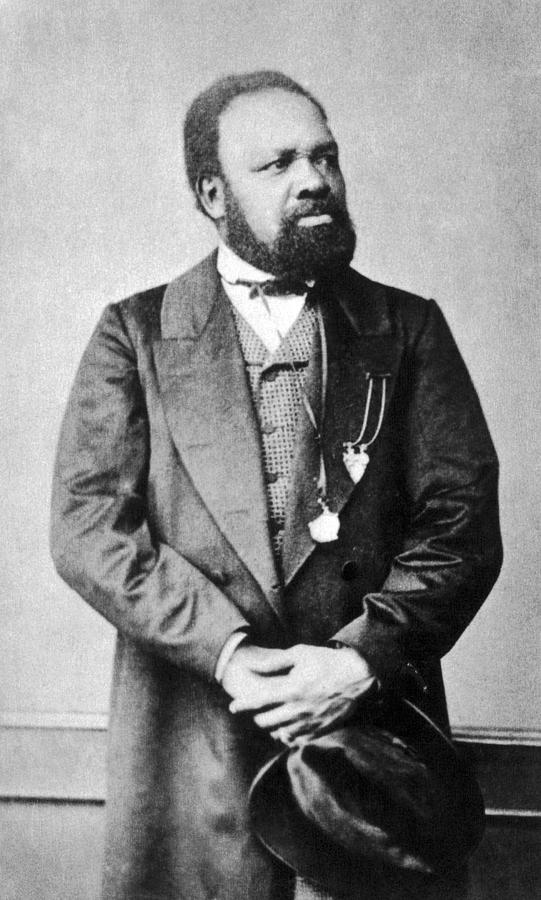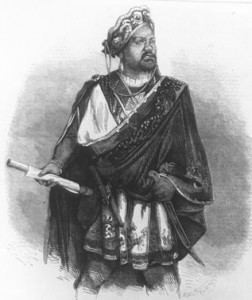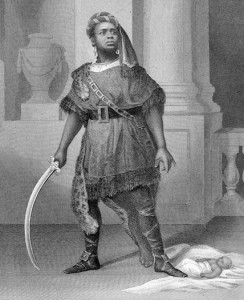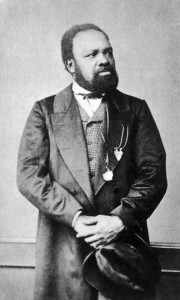
HAPPY HUMP DAY, PRAG OBOTS!
We continue our series on Black Shakespearean Actors…
IRA ALDRIDGE
(1807-1867)
Ira Frederick Aldridge (July 24, 1807 – August 7, 1867) was an American and later British stage actor who made his career largely on the London stage and in Europe, especially in Shakespearean roles. He is the only actor of African-American descent among the 33 actors of the English stage honored with bronze plaques at the Shakespeare Memorial Theatre at Stratford-upon-Avon. He was especially popular in Prussia and Russia, where he received top honors from heads of state.
Early life and career
Aldridge was born in New York City to Reverend Daniel and Luranah Aldridge July 24, 1807. According to Aldridge, his paternal grandfather was a Christian chief of the Fula in Senegal.[1] At age 13, Aldridge went to the African Free School in New York City, established by the New York Manumission Society for the children of free blacks and slaves. They were given a classical education, with the study of English grammar, writing, mathematics, geography, and astronomy.[2] His early exposure to theater included viewing plays from the high balcony of the Park Theatre, New York’s leading theater of the time.
Aldridge’s first professional acting experience was in the early 1820s with the company associated with the African Grove, an African-American theatre. He debuted as Rolla in Pizzaro. He went on to play Shakespeare’s Romeo and later became a notable Hamlet.
Confronted with the persistent discrimination which black actors endured in the United States, Aldridge emigrated to England, where he first worked as a dresser to the British actor Henry Wallack. According to the scholar Shane White, English people had heard of the African Theatre because of British actor and comedian Charles Mathews, so Aldridge associated himself with that.[3] Bernth Lindfors says,
“[W]hen Aldridge starts appearing on the stage at the Royalty Theatre, he’s just called a gentleman of color. But when he moves over to the Royal Coburg, he’s advertised in the first playbill as the American Tragedian from the African Theater New York City. The second playbill refers to him as ‘The African Tragedian.’ So everybody goes to the theater expecting to laugh because this is the man they think Mathews saw in New York City.”[4]
In his performances, Aldridge used his skill to reverse what was expected.[4]

Aldridge performed scenes from Othello that stunned reviewers. One critic wrote, “In Othello (Aldridge) delivers the most difficult passages with a degree of correctness that surprises the beholder.”[5] He gradually progressed to larger roles; by 1825, he had top billing at London’s Coburg Theatre as Oronoko in A Slave’s Revenge, soon to be followed by the role of Gambia in The Slave, and the title role of Shakespeare’s Othello. He also played major roles in plays such as The Castle Spectre and The Padlock, and played several roles of specifically white characters, including Captain Dirk Hatteraick and Bertram in Rev. R. C. Maturin’s Bertram, the title role in Shakespeare’s Richard III, and Shylock in The Merchant of Venice.
Touring and later years
In 1831 Aldridge successfully played in Dublin; several locations in southern Ireland, where he created a sensation in the small towns; as well as in Bath, England and Edinburgh, Scotland. The actor Edmund Kean praised his Othello; some took him to task for taking liberties with the text, while others attacked his race. Since he was an American black actor from the African Theater, the Times called him the “African Roscius”, after the famed actor of ancient Rome. Aldridge used this to his benefit and expanded African references in his biography that appeared in playbills.[4]
Aldridge first toured to continental Europe in 1852, with successes in

Germany, where he was presented to the Duchess of Saxe-Coburg-Gotha, performed for Frederick William IV of Prussia, and performed in Budapest. An 1858 tour took him to Serbia and to Imperial Russia, where he became acquainted with Count Fyodor Tolstoy, Mikhail Shchepkin and the Ukrainian poet and artist Taras Shevchenko, who did his portrait in pastel (left).
Now of an appropriate age, about this time, he played the title role of King Lear (in England) for the first time. He purchased some property in England, toured Russia again (1862), and applied for British citizenship (1863).
Marriage and family
Soon after going to England, in 1824 Aldridge married Margaret Gill, an English woman. They were married for 40 years before her death in 1864.
A year after Margaret’s death, on April 20, 1865, Aldridge married his mistress, the self-styled Swedish countess Amanda von Brandt, with whom he already had a son, Ira Daniel. They had four more children: Irene Luranah, Ira Frederick and Amanda Aldridge, who all went on to musical careers, the two girls as opera singers. Their daughter Rachael Frederica was born shortly after Aldridge’s death and died in infancy.
Aldridge spent most of his final years with his family in Russia and continental Europe, interspersed with occasional visits to England. He planned to return to the post-Civil-War United States, but he died in August 1867 while visiting Łódź, Poland.
His remains were buried in the city’s Evangelical Cemetery; 23 years passed before a proper tombstone was erected. His grave is tended by the Society of Polish Artists of Film and Theatre.
A half-length portrait of 1826 by James Northcote of Aldridge dressed for the role of Othello, but in a relatively undramatic portrait pose, is on display at the Manchester Art Gallery (in the Manchester section); Aldridge performed in the city many times.[6] A blue plaque unveiled in 2007 commemorates Aldridge at 5 Hamlet Road in Upper Norwood, London.[7] The plaque describes him as the ‘African Roscius’.[7]
(SOURCE: Wikipedia)
*FUN FACT*
Ira Aldridge’s daughter, Amanda Christina Elizabeth Aldridge, was a opera singer who taught Marian Anderson and Paul Robeson!

